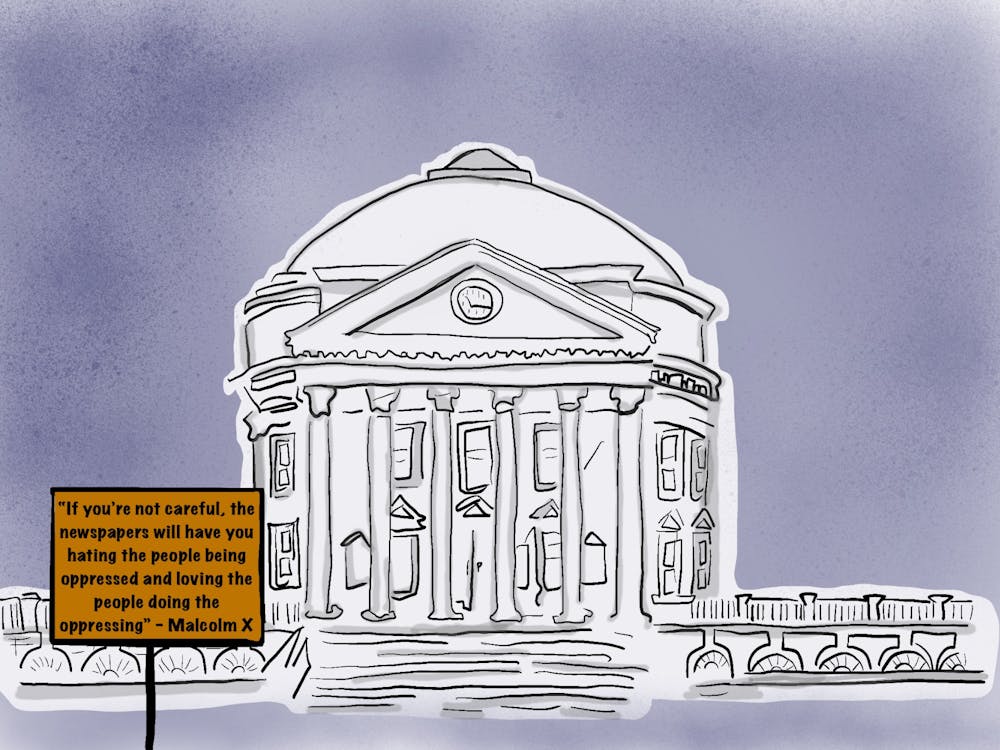In 1987, the University’s Task Force on Afro-American Affairs issued a report called “An Audacious Faith.” Among many issues, the report noted a need to improve the then-Afro-American Studies program; the need to hire more black faculty; the need for a better allocation of resources to the Office of African-American Affairs (OAAA); and a need to improve relations between the University and the black community in Charlottesville. In 2007, University students and organizations compiled “An Audacious Faith II.” The issues in the first report and second differ very little, and now, in 2014, those issues seem highly relevant still. Taken together, the lack of administrative response to these ongoing issues is problematic.
This lack of response could be due to a lack of communication between the black undergraduate community and the Office of the Dean of Students (ODOS). The Office of African-American Affairs is a fantastic resource, but, according to several student leaders, the administration often treats it as the primary resource for black students, funneling those students into a specific set of administrators and separating them from ODOS. Joy Omenyi, president of the Black Student Alliance (BSA), points in particular to administrators’ tendencies to carbon copy Maurice Apprey, Dean of African-American Affairs, whenever emailing black students, among other ways of diverting those students to OAAA. “Everything Dean Groves has to do for a typical student,” she says, “If it were a black student, either Dean Apprey would be taking care of it or he’d be in the room while they take care of it.” She adds, “In all actuality, Dean Apprey is our Dean of Students.”
VJ Jenkins, president of the University’s chapter of the NAACP, also noted experiences in which administrators directed him to OAAA unnecessarily. “OAAA has become a crutch of the University administration,” Jenkins wrote in an email. “The persisting attitude seems to be, ‘Why deal with it, when someone else can?’”
Dean Groves highlights that “ODOS is a resource to all students,” but it appears black students in particular do not feel this way. Although Groves insists that “if a student comes in to see ODOS, we handle it directly,” for whatever reason there is a very problematic disconnect between ODOS and these members of the student body.
And this tendency to separate the black community administratively can affect perceptions of student race-relations; because there’s no facilitated, sustained dialogue on the subject, the administration and student body both tend to discuss the issue reactively, if and when racially-motivated acts occur. This can contribute, according to Dean Apprey, to the belief that such acts are a-historical or anomalous. “I think administrators like good news, in general, and that’s the nature of the work. Who wants to deal with racial conflict every day?” Apprey notes. But personally, Apprey says, “I wake up every morning wondering what is going to rear its ugly head. If nothing happens, I’m very happy; if something happens, I’m not surprised. Those of us who are steeped in history, that’s how we think.”
As Apprey says, racial conflicts at the University are neither a-historical nor infrequent. According to Omenyi, “Every single weekend when someone crosses Beta Bridge they get called the n-word. . . there are plenty of incidents and just because they’re not reported doesn’t mean they don’t occur.” BSA Political Action Chair Aryn Frazier agrees, writing in an email that “race relations are in need of improvement.”
But the administration fails to acknowledge this. As my fellow columnist Nazar Aljassar noted last year, the administrative response to the painting of a racial slur on Beta Bridge treated it, as Apprey alluded to, as though the incident were isolated. But, Frazier says, “we can’t act like people exist in a vacuum.” Dean Groves noted in an email his belief that “the vast majority of students of all races at UVA work collaboratively and in a respectful and inclusive manner with one another.” Though he cited that “there is room for improvement,” this overwhelmingly positive view of race relations does not appear to align with student experiences.
And perhaps this is due to a general disinterest in the black community. Omenyi says, “Not even making direct contact with Dean Groves, I already know what his favorite CIOs are.” While Groves says “we try to be equitable in the attention we provide,” students do not agree. When the BSA hosted a rally in response to the ongoing racial conflict in Ferguson, administrators did show up — but, Omenyi says, it was “not in solidarity or to show support.” It appears it was (ironically) to police the event.
Of course, student race relations cannot be solved solely by administrative attention. But that appears to be the right place to start. Apprey cites the need “to have structures in place, so that when the conflicts come, they do not become malignant.” This includes promoting dialogue about issues of race — and the administration can and should lead such dialogues. As Omenyi notes, “With the administration leading the conversation, I think it’s more powerful.”
Frazier says the solution starts with changing administrative rhetoric to acknowledge the widespread nature of prejudice. “If administrators would engage in a serious conversation on race relations. . . I think the student body would follow suit,” she says.
But dialogue is not the only appropriate response. As Omenyi notes — and as was outlined in “An Audacious Faith II” — the Carter G. Woodson Institute for African and African-American Studies (AAAS) is still a program and not a department. The Office of African-American Affairs is still housed in an un-renovated building that was intended to be a temporary location for that office. The African-American student population has dropped to 6 percent, and the African-American graduation rate has dropped over 6 percent in the past decade. When the problems facing black students mirror those facing students in 1987, an administrative response is necessary.
Dani Bernstein is a Senior Associate Editor for The Cavalier Daily. She can be reached at d.bernstein@cavalierdaily.com.




